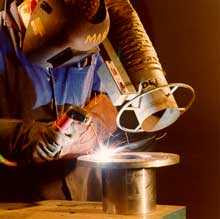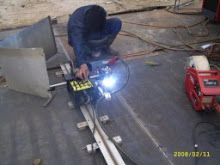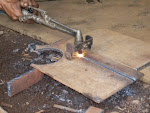Naqi Akbar
LAHORE - Pakistan Railway is consciously trying to cover up the ‘sabotage’ aspect of the December 19 Mehrabpur accident; in the process avoiding a possible clash with the provincial administration; in this case the Sindh government.
Conversations with knowledgeable sources by TheNation revealed that the ‘welded area contraction’ theory advanced by the Railways high ups was based on faulty parameters and that the magnitude of the accident witnessed in the small Sindh station could not have been caused by the simple break rather that needed the dismantling of the structure in a way that the track could not withhold a high speed locomotive and cause a massive accident.
Sources told TheNation that the high ranking PR officials ‘welding theory’ was even rejected by the DS Lahore who was by chance onboard his salon in the 15 UP Karachi Express on that fateful mid night crash.
Having the first hand knowledge of the accident, he pointed to the source that the extent of damage would not have been possible without the sabotage option being considered.
A former railway engineer on the condition of not being quoted pointed out that the winter season was usually followed by contraction of the tracks and that contraction was generally triangular shaped in nature; with the upper section breakage more wider than the crack in the base area. He said that these types of breaks were numerous along the whole track and that crack never dismantles the piece of track in a manner that it can be dismantled by speedy locomotive.
He pointed out that if a locomotive passes over such a crack, at most there are jolts as are very commonly experienced in the rail journey but does not dislocates the track as has been claimed by the high ups. He pointed out that going by the fact that the track over which the accident took place was straight simple contraction led welding break as not the probable cause of the crash.
He argued that weld break if coupled with dismantled fishplates and tracks could make the accident possible. In this context sources pointed out that going for the sabotage option was likely to create friction between the Pakistan Railway and the provincial police as the PR itself boasted of a separate police force meant to keep the security onboard and on track.
Accepting the terror plot proposition was tantamount to accepting a security lapse by the railway itself. As things stand the official report is expected in few weeks but the fact remains that there is a dichotomy of perceptions between the PR high ups and the engineering experts.
sumber artikel : www.aws.org
06 February, 2008
Sulitnya Mengelas Besi Cor
Besi cor sebagai sebuah logam dari kelompok paduan Besi memang termasuk logam yang sangat sulit dilas. Sulit dalam arti bukan tidak terjadi sambungan, akan tetapi lebih pada adanya retakan di sekitar logam las dan logam induk yang dilas. Kendala itu lebih banyak disebabkan oleh karakteristik dari besi cor itu sendiri. Logam-logam paduan besi yang banyak mengandung Karbon (lebih dari 0,3%) relatif lebih sulit dilas.
Secara umum, permasalahan dalam pengelasan besi cor kelabu adalah dijelaskan sebagai berikut :
1. Grafit yang tersebar di berbagai tempat akibat segregasi mungkin saja sebagian dari grafit itu berubah menjadi Sementit sehingga sebagian logam las berubah menjadi besi cor putih yang sangat keras. Perubahan ini dikenal dengan istilah “Efek Cil” dan mungkin saja dapat terjadi di HAZ selain di logam las. Adanya efek cil terjadi akibat “hilangnya” unsur Karbon dan Silikon sehingga kandungan kedua unsur itu menurun. Kemudian kondisinya diperburuk dengan pendinginan yang cepat di kedua daerah itu sehingga menghasilkan besi cor putih dengan ciri adanya struktur mikro Sementit.
2. Ketika terjadi pembekuan, akibat gradien temperatur yang besar menghasilkan regangan dan tegangan termal pada daerah tertentu. Regangan dan tegangan termal ini pada akhirnya dapat memicu pembentukan retak baik di logam las maupun di HAZ.
3. Besi cor memiliki temperatur cair relatif rendah dan perubahan dari fasa padat ke cair dan sebaliknya dapat berlangsung dengan sangat cepat. Akibatnya, gas-gas yang ikut terlarut dalam kubangan logam las tidak memiliki cukup waktu untuk keluar dari daerah itu dan akhirnya terjebak. Dengan demikian kadang-kadang setelah pengelasan, logam las banyak mengandung porositas.
4. Cairan logam besi cor sangat “encer” sehingga mampu alir nya sangat baik. Dengan karakter seperti itu, pengelasan besi cor akan menghasilkan sambungan yang optimal apabila dilakukan dalam posisi mendatar.
5. Adanya lapisan oksida (yaitu Silikon-oksida dan Mangan-oksida) dipermukaan logam yang memiliki titik cair lebih tinggi dari logam induknya. Karenanya, selam pengelasan mungkin saja terjadi fusi yang tidak sempurna antara logam las dan logam induk.
Besi cor sebagai sebuah logam dari kelompok paduan Besi memang termasuk logam yang sangat sulit dilas. Sulit dalam arti bukan tidak terjadi sambungan, akan tetapi lebih pada adanya retakan di sekitar logam las dan logam induk yang dilas. Kendala itu lebih banyak disebabkan oleh karakteristik dari besi cor itu sendiri. Logam-logam paduan besi yang banyak mengandung Karbon (lebih dari 0,3%) relatif lebih sulit dilas.
Secara umum, permasalahan dalam pengelasan besi cor kelabu adalah dijelaskan sebagai berikut :
1. Grafit yang tersebar di berbagai tempat akibat segregasi mungkin saja sebagian dari grafit itu berubah menjadi Sementit sehingga sebagian logam las berubah menjadi besi cor putih yang sangat keras. Perubahan ini dikenal dengan istilah “Efek Cil” dan mungkin saja dapat terjadi di HAZ selain di logam las. Adanya efek cil terjadi akibat “hilangnya” unsur Karbon dan Silikon sehingga kandungan kedua unsur itu menurun. Kemudian kondisinya diperburuk dengan pendinginan yang cepat di kedua daerah itu sehingga menghasilkan besi cor putih dengan ciri adanya struktur mikro Sementit.
2. Ketika terjadi pembekuan, akibat gradien temperatur yang besar menghasilkan regangan dan tegangan termal pada daerah tertentu. Regangan dan tegangan termal ini pada akhirnya dapat memicu pembentukan retak baik di logam las maupun di HAZ.
3. Besi cor memiliki temperatur cair relatif rendah dan perubahan dari fasa padat ke cair dan sebaliknya dapat berlangsung dengan sangat cepat. Akibatnya, gas-gas yang ikut terlarut dalam kubangan logam las tidak memiliki cukup waktu untuk keluar dari daerah itu dan akhirnya terjebak. Dengan demikian kadang-kadang setelah pengelasan, logam las banyak mengandung porositas.
4. Cairan logam besi cor sangat “encer” sehingga mampu alir nya sangat baik. Dengan karakter seperti itu, pengelasan besi cor akan menghasilkan sambungan yang optimal apabila dilakukan dalam posisi mendatar.
5. Adanya lapisan oksida (yaitu Silikon-oksida dan Mangan-oksida) dipermukaan logam yang memiliki titik cair lebih tinggi dari logam induknya. Karenanya, selam pengelasan mungkin saja terjadi fusi yang tidak sempurna antara logam las dan logam induk.
03 February, 2008
Istilah Las Karbit
Hingga sekarang, kebanyakan orang mengenal LAS GAS sebagai las karbit. Sesungguhnya nama yang benar menurut AWS (american welding society) adalah OXY-ACETYLEN WELDING atau Las Gas Oksi-Asetilen. Nama karbit itu sendiri sebenarnya adalah BATU yang dipakai untuk menghasilkan gas ASETILEN.
Las Gas Oksi-Asetilen terdiri dari empat suku kata yang berarti proses pengelasan yang sumber panasnya berupa nyala api berasal dari hasil reaksi gas Oksigen dan gas Asetilen.

Nyala api yang dihasilkan di ujung torkh (nosel) merupakan hasil perbandingan gas oksigen (O2) dan gas asetilen (C2H2). Jika perbandingan gas oksigen dan asetilen sama besar atau 1 : 1 maka dihasilkan jenis nyala netral. Nyala ini dipakai jika akan mengelas baja, besi cor, baja tahan karat dan tembaga. Jenis nyala kedua adalah nyala karburasi dimana tekanan gas asetilen lebih besar dari gas oksigen atau rasio O2 : C2H2 <>n aluminium dan logam non-ferro lainnya, dan pengelasan besi cor
Hingga sekarang, kebanyakan orang mengenal LAS GAS sebagai las karbit. Sesungguhnya nama yang benar menurut AWS (american welding society) adalah OXY-ACETYLEN WELDING atau Las Gas Oksi-Asetilen. Nama karbit itu sendiri sebenarnya adalah BATU yang dipakai untuk menghasilkan gas ASETILEN.
Las Gas Oksi-Asetilen terdiri dari empat suku kata yang berarti proses pengelasan yang sumber panasnya berupa nyala api berasal dari hasil reaksi gas Oksigen dan gas Asetilen.

Nyala api yang dihasilkan di ujung torkh (nosel) merupakan hasil perbandingan gas oksigen (O2) dan gas asetilen (C2H2). Jika perbandingan gas oksigen dan asetilen sama besar atau 1 : 1 maka dihasilkan jenis nyala netral. Nyala ini dipakai jika akan mengelas baja, besi cor, baja tahan karat dan tembaga. Jenis nyala kedua adalah nyala karburasi dimana tekanan gas asetilen lebih besar dari gas oksigen atau rasio O2 : C2H2 <>n aluminium dan logam non-ferro lainnya, dan pengelasan besi cor
Subscribe to:
Posts (Atom)
google search






